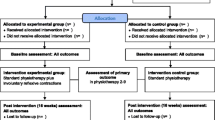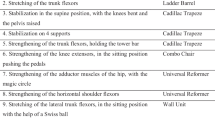Abstract
A pretest-post-test design (n=14) was used to investigate pelvic floor muscle (PFM) strength over a 2-month training period using vaginal cones with pelvic floor exercises in the treatment of female stress incontinence, and to correlate any changes in muscle strength with objective and subjective measures of stress incontinence. PFM strength was assessed by vaginal examination and the ability to retain the cones. The symptom of stress incontinence was assessed using rating scales, and measured objectively by the extended pad test. The results showed a significant increase in muscle strength (P<0.05). An unexpected finding was that most of the improvement in PFM function occurred in a 1-week baseline assessment period before training was commenced. It is therefore suggested that the increase in force generation occurred due to a process of neural adaptation rather than muscle hypertrophy. No significant correlations were found between muscle strength and objective or subjective measures of stress incontinence.
Similar content being viewed by others
References
Wolin LH. Stress incontinence in young healthy nulliparous female subjects.J Urol 1969;101:545–549
Nemir A, Middleton RP. Stress incontinence in young nulliparous women.Am. J Obstet Gynecol 1954;68:1166–1168
Yarnell JW, Voyle GJ, Sweetman PM et al. The prevalence and severity of urinary incontinence in women.J Epidemiol Commun Health 1981;35:71–74
Henalla SM, Kirwan P, Castleden CM et al. The effect of pelvic floor exercises in the treatment of genuine stress incontinence in women at two hospitals.Br J Obstet Gynaecol 1988;95:602–606
Shepherd AM, Montgomery E, Anderson RS. Treatment of genuine stress incontinence with a new perineometer.Physiotherapy 1983;69:109–110
Klarskov P, Belving D, Bischoff N et al. Pelvic floor exercises versus surgery for female urinary stress incontinence.Urol Int 1986;41:129–132
Bo K, Hagen R, Joregensen J et al. The effect of two different pelvic floor muscle exercise programs in the treatment of urinary stress incontinence in women.Neurourol Urodyn 1989;8:4:355–356
Hesse U, Schussler B, Frimberger J et al. Effectiveness of a three step pelvic floor re-education in the treatment of stress urinary incontinence: a clinical assessment.Neurourol Urodyn 1990;94:397–398
Devreese A, De Weerdt R, Lysens R. Effect of physiotherapy in stress incontinence and urge incontinence. Proceedings of the World Congress of Physiotherapy, 1991
Peattie AB, Plevnik S, Stanton SL. Vaginal cones: a conservative method of treating genuine stress incontinence.Br J Obstet Gynaecol 1988a;95:1049–1053
Peattie AB, Plevnik S. Cones versus physiotherapy as conservative management of genuine stress incontinence.Neurourol Urodyn 1988b;7:3:265–266
Olah KS, Bridges N, Denning J et al. The conservative management of patients with symptoms of stress incontinence: a randomized, prospective study comparing weighted vaginal cones and interferential therapy.Am J Obstet Gynecol 1990;162:87–92
Haken J, Bennes C, Cardozo L, Cutner A. A randomized trial of vaginal cones and pelvic floor exercises in the management of genuine stress incontinence.Neurourol Urodyn 1991;10:393–394
Soutter WP. In: Shaw R, Soutter WP, Stanton S (eds.) Gynaecology. London: Churchill Livingstone, 1992;385–395
Schreiter E, Fuchs P, Stockamp K. Estrogenic sensitivity of alpha receptors in the urethral musculature.Urol Internationalis 1976;31:13–19
Laycock J. Assessment and treatment of pelvic floor dysfunction: physiotherapy in the management of pelvic floor dysfunction in relation to female urinary incontinence. PhD Thesis University of Bradford, 1992
Sutherst J, Brown M, Shawer M. Assessing the severity of urinary incontinence in women by weighing perineal pads.Lancet 1981;1128–1130
Brinks CA, Sampselle CM, Wells TJ et al. A digital test for pelvic muscle strength in older women with urinary incontinence.Nursing Res 1989;38:169–199
Jones DA, Round JM. Skeletal muscle in health and disease. Manchester: Manchester University Press, 1990; pp. 99–157
Hahn I, Ohlsson B, Lindstrom S. Pelvic floor elevation force—a new technique to assess pelvic floor function.Neurourol Urodyn 1991;10:4:396–397
Wilson PD, Al Samerrai T, Deakin M et al. An objective assessment of physiotherapy for female stress incontinence.Br J Obstet Gynaecol 1987;94:575–582
Author information
Authors and Affiliations
Additional information
Editorial Comment: Vaginal cones are gaining in popularity as a method of therapy for stress incontinence. As in this study, the symptom of stress incontinence was enough to begin treatment and objective documentation of the diagnosis was not undertaken. The therapy has no side-effects and only requires that the patient is motivated enough to put the cone in the vagina and take it out after a prescribed time period. Everything else is automatic. Biofeedback from the perception of the cone falling out provides the stimulus for pelvic floor contraction. Success rates are high, with 21% cured and 29% improved for an overall improvement rate of 50%. Such therapies may be tried before diagnosis, and certainly before expensive surgical treatment.
Rights and permissions
About this article
Cite this article
Wrigley, T. The effect of training with vaginal weighted cones and pelvic floor exercises on the strength of the pelvic floor muscles: A pilot study. Int Urogynecol J 6, 4–9 (1995). https://doi.org/10.1007/BF01961840
Issue Date:
DOI: https://doi.org/10.1007/BF01961840




